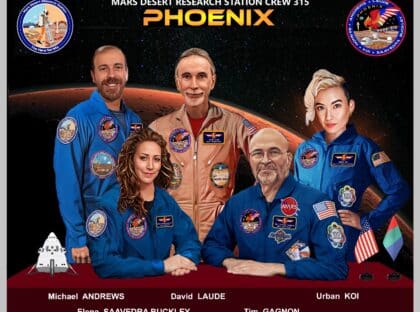By Shriya Sawant, Guest Writer, Red Planet Bound, 09.19.24
A heated point of contention between space advocates and environmental advocates can be summarized by one succinct phrase: whether to “Save Earth or Settle Mars”. You might also recognize the phrase “Save Earth and Then Go to Mars,” or vice versa “Why Going to Space will Save Humanity” across many articles, tweets, and blogs. However, a fallacy in all of these statements is that they depict sustainability movements and space exploration research to be polar opposites, when nothing could be farther from the truth.
Sustainability efforts and human space exploration missions both aim to optimize the use of limited resources such as energy, water, and food. The environmentalism movement does so to protect the natural resources of Earth from overconsumption, while for space exploration it is to expand the duration of manned missions and decrease mission costs. Thus, many of the innovations from these fields are applicable to one another. NASA’s Spinoffs series documents how the technologies the agency developed for space exploration have been commercialized for use on Earth, featuring a section for energy and the environment. Famous examples include improvements in solar panel technology for robotic space missions, agricultural workers using satellite data of Earth to maximize crop yield, and one of the most efficient water recycling systems currently operating on the International Space Station: The Environmental Control and Life Support System (ECLSS). Furthermore, satellite data of Earth is used to track weather and climate patterns. Our understanding of how human activity affects the planet wouldn’t be complete without the help of space technology.
A popular argument against space efforts related to its costs, the “Why Spend Money on Space When it Can Be Spent on Earth?” argument, can be immediately jettisoned when we look at the tremendous economic output generated by these commercialized space technologies. In 2021, NASA generated an estimated 71.2 billion in economic output compared to its budget of 22.6 billion, returning over 3 times its original investment. The money spent on the space exploration program can be seen all around you in the forms of new technology, research, and boosting local economies in terms of direct employment and contractors. Space technology is what enables the GPS that powers Google Maps when you embark on a road trip, the memory foam in your mattresses and shoes (originally developed to help pilots withstand high g’s), the foil blankets you don after running a marathon, and much more. Every dollar spent on space is very much spent on Earth as well, in ways that have directly improved our quality of life.
This effect is amplified by the rise of the private space industry, who through competition and pioneering reusable launch vehicles, are reducing the cost of space missions. This democratizes access to space -in terms of lower prices and the number of aerospace companies capable of delivering payloads- and allows more organizations to test their experiments or conduct operations in microgravity, setting the foundations for a flourishing space-based economy and creating returns in commercialized space research. An example of a business model that benefits both Mars and Earth is the Mars Society’s Mars Technology Institute (MTI), which seeks to develop the technologies needed to settle the red planet and have Martian cities become financially self-sufficient by licensing their findings for use on Earth.
Another value of space exploration is that the frugality of living in space can teach us how to use resources more efficiently on Earth. This is best highlighted by In-Situ Resource Utilization (ISRU), or the practice of ‘living off the land’ of another planet as much as possible, such as mining natural resources and in-house production. ISRU allows long-term space missions to be more self-sufficient and thus more viable. Having a mission’s life support systems not be dependent on supplies from Earth would greatly reduce the risk of failure and the cost of the mission, as there would be less payload needed to be brought from Earth. Seeing Martian settlers learning to live off so little can inspire people on Earth to use their resources more wisely. Additionally, the rare mineral deposits located on other worlds and in the asteroid belt can alleviate resource shortages on Earth.
Many astronauts have experienced the Overview Effect, whereupon looking down at Earth from space they realize how remarkable our planet is, fostering a strong connection to humanity. Space exploration, in addition to its environmental and economic contributions, has served as a form of diplomacy between nations. These collaborations include the International Space Station, Mars robotic exploration program, and probes which have returned immense scientific knowledge to all. A human Mars mission program will continue this effect by allowing various government agencies and companies to contribute their astronauts, equipment, and research. Space exploration inherently demands teamwork and is an interdisciplinary effort that enlists people from all fields of science and engineering. The field has built countless international communities dedicated to having humanity step out of its cradle. The members of the Mars Society seek to transform themselves from being just proponents of human Mars missions to the settlers of the red planet.
Settling Mars will be a testament to humanity’s unity, resolve, and ingenuity in undertaking what would be one of the most significant endeavors of the 21st century and beyond. Venturing forth to the cosmos will deepen our understanding of the origins of life and the universe, sparking a paradigm shift in how humanity sees itself. By learning how to adapt to the harsh environments of outer space and other worlds, we will transform into a more resilient species. Mars is not meant to replace Earth but will complement our planet and serve as our steppingstone to a multiplanetary future. It is for the benefit of Earth and humanity that we should target the first human Mars missions to happen in the next decade.
We want to welcome Shriya Sawant as a new guest writer for our Red Planet Bound blog. Shriya is a U.S. high school student with plans to go into the space industry. Her specific areas of interest include space architecture, propulsion, and human Mars exploration. In addition, she is fascinated by how the research and technology developed for space exploration can be used to benefit humanity and Earth.
Image: Orbital Today


